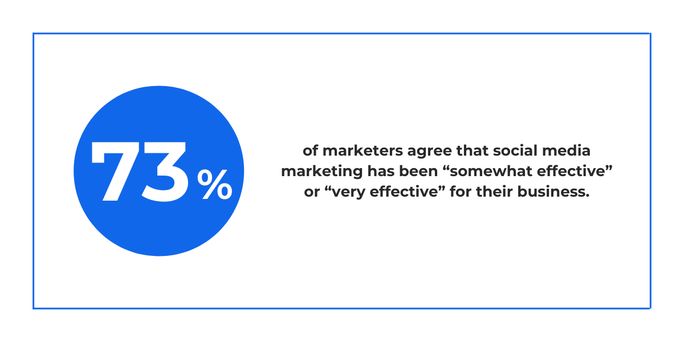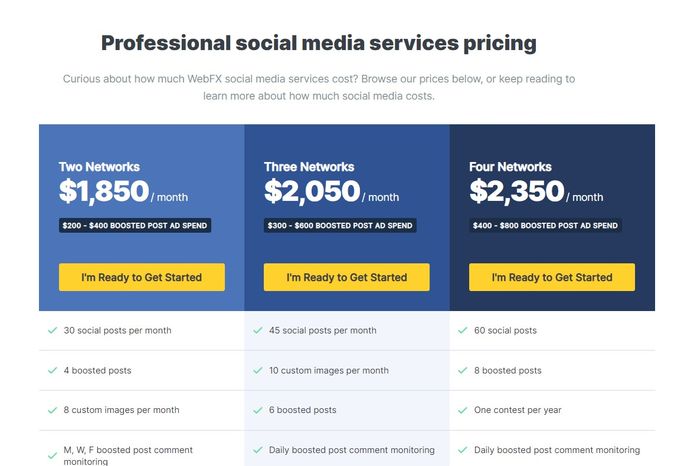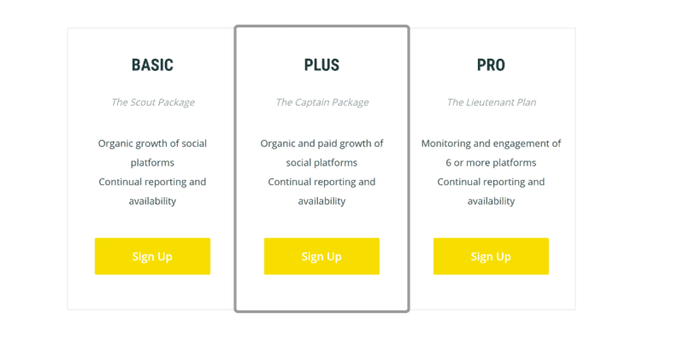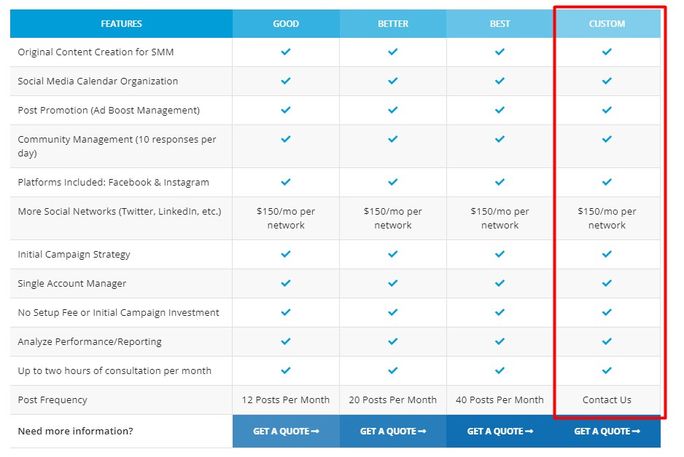How much should I charge for my social media management services?
It’s a hair-pulling question every new social media manager or agency owner asks themselves before making the client call. Especially for social media marketing agency for small business.
Not only new marketers, but this question is also prevalent in the minds of owners of social media marketing agency for small businessand marketing consultants trying to change their business model for growth.
But the aim is the same – to have a social media management services pricing model which is good enough to keep the business afloat but not much to lose the clients to competitors.
Since you are here, your mind is also grappling with the same question.
To be fair, It’s not an easy question and indeed doesn’t have a one-size-fits-all answer. So let us help settle you for a perfect social media management pricing model, be it social media marketing agency for small business or large enterprises.
Let’s get started!
What Does Social Media Management Cost Look Like?
Before we dive into the overall social media management cost, it is important to understand the cost of social media management can vary from business to business. It is highly depended on all the services you opt for.
So, including all social media management services an average of opting for social media management program roughly gets to $13,000 per month (estimation). This estimation may include one or more social management services like, advertisement campaign costs, content creation costs, and social media management costs.
- Content creation costs: $6,900 per month (Estimation)
- Social platform management: $5,200 per month (Estimation)
- Advertising on social media: $5’200 per month (Estimation)
- Total estimation: $17,300 per month
Charge higher prices,
confidently.
SocialPilot has all the social media tools
you’ll ever need to charge a premium price.
What do Social Media Marketing Services Include?
Nowadays, a luminous social media presence is essential for every business hoping to make it big. And social media marketing agency for small business are highly in demand because they operate on limited funds.

That settles the need for social media marketing and the worth of you as a social media marketer.
However, sometimes clients who are yet to foray into social media marketing and don’t have much knowledge around it underrate the social marketer’s job as “an uncomplicated process to post captions every day.”
In such cases, you need to step-up and enlighten them with the roles and responsibilities of a social media specialist.
Here are some of the common ones for your reference:
- Handling multiple social media accounts
- Creating unique posts for different platforms
- Tracking effectiveness of social posts
- Bolstering lead generation campaigns
- Engaging with the audience to understand buyer’s persona
- Creating sales funnel
- Providing customer support on social media
- Competitor research
- Maintaining the visual and verbal brand tone
In simple words, the job of a social media manager includes content production, campaign management, reporting, tracking, community management, and customer service.
Phew, that’s a lot. You already deserve a break.
And a list of the best social media management tools that can help manage your agency’s workload.
4 Ways to Charge for Your Social Media Management Services
Before deciding on a price for your social media management services, you need to understand the different ways you can charge clients.
There are 4 different ways to charge for your services:
1. Hourly
Charging hourly is the most suitable pricing model for freelancers who are just starting out. You can sort out the details with your clients and decide on the total number of hours you will work per week or month.
Typically a beginner manages to get around $25 – $35/hour in starting, and the number goes up as the experience increases.
Pros:
- You know how much time it will take to finish the job.
- You can charge more for any extra work
Cons:
- It’s hard to scale your business with the hourly model
- You won’t get any incentive to work faster
2. Monthly
After building some experience and establishing a relationship with your clients, you can move to the monthly retainer pricing model.
In the monthly retainer model, you get a recurring income every month in exchange for your social media management services.
Pros:
- No need to constantly search for new clients
- It gets you a steady income every month
- It makes budgeting easier for your clients
- Less time-constraint and organized enough to take other clients
Cons:
- The model is pricey for newer clients
- Clients can demand consistent edits and reject ideas multiple times
3. Project-based
This option is best when you undertake a specific long project, such as developing a social media ad campaign, promoting a particular product, or a brand-enhancing identity package.
Clients usually select this project when they have to kick-start something with the help of experts and then eventually run it themselves. You can quote them on an hourly basis after estimating how many hours it would take you to complete the project.
Pros:
- It’s easier to scale than the hourly model
- The flexibility of outsourcing work
Cons:
- You will have to work at the client’s pace
- Less visibility on the project finishing date
4. Package-based
Monthly packages are the most efficient pricing model for your social media management services.
You can create a set of packages offering different services and charge on a monthly or yearly basis.
Different pricing enables you to get hold of the prospects who are on a tight budget. You can also create custom packages for large enterprises looking for something more than your preset packages offer.
Pros:
- Constant flow of income from clients
- Straightforward proposals make it easy for clients to choose you
- You know the services you have to offer from the start
- Easy to scale your business
Cons:
- It’s hard for inexperienced individuals and agency owners to come up with the perfect pricing packages.
And we are about to change that. The rest of the blog will follow how you can create perfect pricing packages from scratch.
How to Decide a Price Range for Your Social Media Management Services?
On the quest to create a perfect pricing package as a freelancer or an agency owner, you need to go through the following steps.
Step 1: Know Your Worth
First thing first, you need to determine what you as a social media specialist bring to the table. Your level of experience and qualification directly impacts the pricing you can charge.
Obviously, a seasoned marketer would charge and quickly get more money than a freelancer for undertaking the same number of services.
So make sure you consider the following factors when deriving your social media management services pricing:
- How much Industry experience do you have?
- What education and certifications have you done?
- Does your clientele include big names?
- What special skills and expertise do you offer?
Step 2: Research Your Direct Competitors
Your direct competitors are the key to finding a reference pricing model for your social media marketing and management services.
Look at how your competitors are floating in the market. What is their pricing model?
You can start by making a list of 8-10 competitors and searching through their website for the pricing package.
The chances of finding a fixed pricing page on a small marketing agency website are low, but even one or two references will help you start.
You must also establish connections with marketing professionals on social media groups to find how they charge clients.
But I believe you are already doing all of this to some extent.
So while you perform this exercise, make sure to indulge in finding the pricing structure of only your direct competitors. For you don’t want to waste your time overlooking a freelancer’s pricing model when you are a full-fledged marketing agency.
Wait, how to distinguish my direct competitors?
Your direct competitors are the agencies or individuals who are similar to you in the following aspects:
- Number of employees
- Client industry
- Client company size
- Services offered
Step 3: Take a Look at Your Current Pricing Plan
Once you are done researching competitors, have a go at your own pricing structure.
This step is for the agency owners and freelancers who already have a clientele and a pricing structure in place.
The aim here is to figure out how clients are perceiving your current pricing plan. How is your business working under the current pricing?
Do you get any kind of objection to your current pricing plan?
Are your clients satisfied with your current pricing?
Are your clients suggesting your rates as too high or too low in comparison to others?
Keep an eye for what your clients feel about your pricing. You need to strike a balance in opinions. If 50% of your clients think you are expensive and the other 50% think you are not, then it’s alright.
But, if you notice more people inclining towards either side, then it’s time to rethink your social media management services pricing accordingly.
Here you have to understand that having an inexpensive plan is not always a winning situation. You are probably undercharging for the value you provide and impeding your own business growth.
Step 4: Consider Your Expenses
Pricing greatly depends on how much you will spend on providing your services and running your business.
You want to create a pricing structure that is in line with your customer expectations and covers the cost of running your agency.
Here are some of the expenses you need to consider while making your pricing structure:
Office expenses: Whether you are working from the office or home, with a team or as an individual, you need to spend for the operational cost that includes rent, utilities, equipment, maintenance, supplies, etc.
Service expenses: Investment in multiple tools and software to run marketing campaigns for your clients. This list generally includes task management software, CRM tool, SEO tool, email marketing software, designing tool, social media automation software, etc.
Since this blog revolves just around social media services, you can stick with the expense of social media marketing software.
Employment expenses: Expenses made in providing salary, benefits, insurance, bonuses, and travel expenses to employees.
Professional fees: This cost includes government licensing fees, corporate taxes, legal fees, and other professional or advisory services fees.
Growth cost: In order to reach your audience, you need to have a marketing budget cut out for yourself. The growth expenses cover variable marketing costs such as advertising, conference fees, directory listing fees, traveling expenses, etc.
It also covers the money you want to invest back in the company for growing your business.
Step 5: Consider the Needs of Your Best-fit Clients
In order to create a social media management package, you need to identify the needs of your best-fit clients.
I am talking about the clients you have worked with before and managed to achieve the best results.
So start brainstorming:
- Who are your best clients?
- Which services do you offer them?
- Which of your services turned out to be valuable for clients in getting better impressions, account growth, sales, and leads?
Once you have the answers to all these questions, see if you can duplicate the similar services and approaches in a monthly package for other clients.
Step 6: Create Your Pricing Package
Once you know what your best fit client wants, you can easily carve out a package that other clients would also love.
The best-fit client package can go as the most popular package on your website pricing page. After that, you can create one package which is a tad basic and one which is a bit more inclusive with the extra set of services.
Look at the pricing packages of WebFX.

Although it’s not mandatory to show a price with your social media management packages, you can always keep your prices hidden and allow visitors to ask for a quote.
Look at Yellow hyena’s pricing page:

Sooner or later, you will find clients who won’t like certain aspects of your packages and want to add or exclude some services.
In such cases, you need to have the option of a custom package on your pricing page.

To create custom packages, you need to have a flat rate price sheet with a monthly price on every service you offer. This will allow you to generate a quote for each service and create a custom package for clients who are unsatisfied with preset packages.
Step 7: Test it on Clients and Collect Feedback
Finally, it’s time to release your pricing.
You can start by releasing it to new prospects. Help them understand what each plan offers and which one will be suitable for them over sales calls and emails.
Once you get positive feedback from new clients, introduce the new way of pricing to old clients. See how your old best-fit clients behave to the pricing plan. If you see something not working, be open to making changes.
Do’s and Don’ts of Creating a Pricing Plan
When you are starting to set up your charges, it’s pretty normal to make some mistakes.
But there are a few pitfalls you should avoid for better growth. Similarly, there are a few do’s that will make your transaction with clients smoother.
Don’ts
- Do not let the client decide your fees
- Do not give consultation for free
- Do not offer any service for free, unless you are running an offer
- Don not agree verbally to a project during a meeting
- Don’t be hesitant to tell your clients about extra charges
- Do not take clients who are impractically demanding from the start
- Do not accept the work you are not familiar with
Do’s
- Be confident of your expertise
- Prepare your pricing ahead of time
- Get advance before starting
- Make your proposals with all suitable packages
- Make your pricing structure simple
- Always send a follow-up email after a sales call
- Always execute a contract with the scope of work included
Conclusion
Creating a perfect social media marketing and management services package can be overwhelming. Especially when you don’t know your own worth.
So make sure to be completely aware of the value you provide to the clients. Knowing your worth gives you confidence and helps you at the time of negotiation.
Remember your aim is to create a package that fits the needs of your best-fit clients and covers the cost of running your agency.
Go through your operational expenses, figure your client’s needs, research your competitors, and keep an open door for feedback to make your package reinventing process simple.
Speaking of simple, use SocialPilot to effortlessly manage social media marketing campaigns of multiple clients at once.
SocialPilot is especially made for agencies to work efficiently and scale better.
Experience it yourself – Start your free trial.



